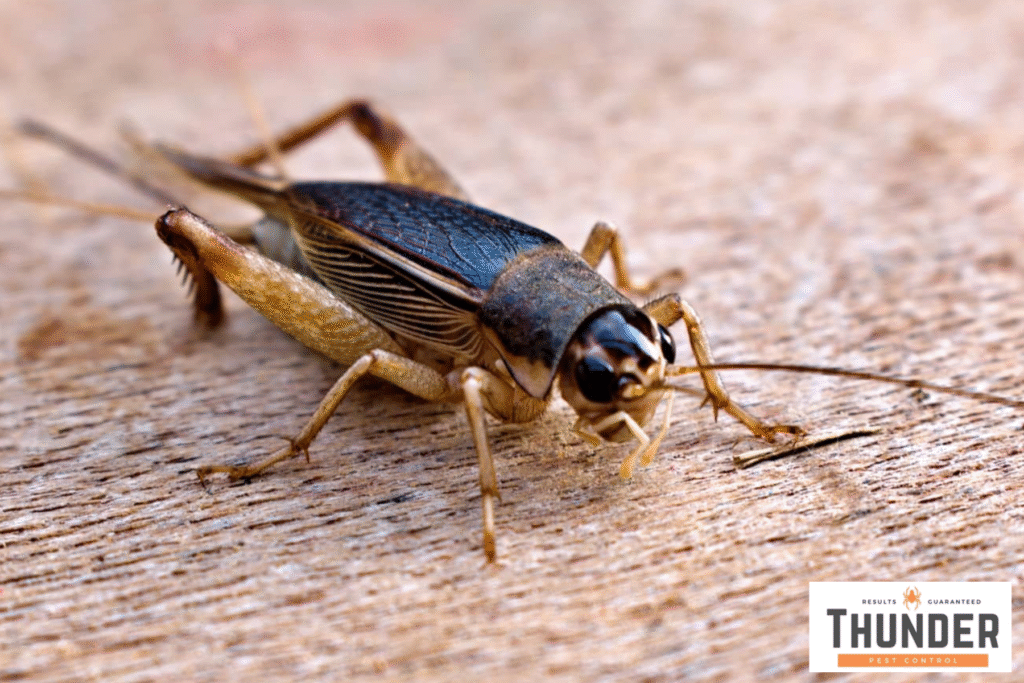When it comes to pests invading your home, crickets are often considered more annoying than dangerous. Their signature chirping is unmistakable and can be a nuisance—especially when it echoes inside your walls at night. But there’s one question that sparks curiosity and concern among homeowners: Can crickets bite?
In this blog post, we’ll explore the facts about cricket bites, their behavior, and what to do if you’re dealing with a cricket problem. Whether you’ve seen them hopping around your basement or chirping on your porch, understanding their habits can help you protect your home.
Understanding Cricket Anatomy
Crickets belong to the insect order Orthoptera, which also includes grasshoppers and katydids. These insects have strong hind legs for jumping, long antennae, and a pair of powerful mandibles used for chewing. It’s these mandibles that lead many people to wonder whether or not crickets can bite.
Yes, crickets do have the physical ability to bite. However, it’s extremely rare for them to bite humans. Crickets are not aggressive insects. They do not seek out people to bite or attack. Instead, their primary goal is to find food, shelter, and a safe place to reproduce.
So, Do Crickets Bite?
The short answer is: Yes, crickets can bite, but it’s highly unlikely and rarely harmful. Most bites happen in extreme situations such as when a cricket is handled or feels threatened. Even then, their bite is generally weak and harmless. In most cases, the bite may not even break the skin.
In rare instances, individuals with sensitive skin may experience mild irritation or redness, but there’s no venom or toxic saliva involved. Crickets are not known to transmit diseases to humans through their bites, unlike other pests like mosquitoes or ticks.
If you’re still asking, do crickets bite? Technically, yes but not in any way that poses significant danger to humans.
Why Would a Cricket Bite?
While rare, a cricket may bite under the following circumstances:
- Self-defense: If the insect feels threatened or trapped.
- Mistaken identity: If a cricket ends up on your skin and mistakes it for food residue.
- Food scarcity: In overcrowded environments or when food sources are limited, crickets may show unusual behavior, including biting.
Still, these scenarios are uncommon. Crickets prefer to feed on organic matter such as plants, fungi, dead insects, and even paper products in your home.
Are Cricket Bites Dangerous?
Cricket bites are not considered dangerous. They do not contain venom and are not known carriers of human diseases through biting. However, like any insect, their presence can pose other problems:
- Property damage: Crickets may chew on fabrics, upholstery, cardboard, or paper products.
- Noise pollution: Their chirping, especially from male crickets, can be loud and disruptive at night.
- Contamination risk: Cricket droppings can contaminate food sources or surfaces, making cleanliness an issue.
So, while the bite itself is not harmful, the presence of crickets in your home could lead to other types of inconveniences and health concerns if not addressed.
How to Avoid Cricket Encounters
If you want to avoid even the smallest risk of being bitten or disturbed by crickets, prevention is key. Here are a few practical tips to minimize their presence in and around your home:
1. Eliminate Food Sources
Crickets are scavengers. Clean up food crumbs, secure garbage bins, and keep pantry items sealed.
2. Reduce Moisture
Crickets are attracted to moist environments. Repair leaks, use dehumidifiers, and ensure proper ventilation in damp areas like basements and crawl spaces.
3. Declutter Indoors and Outdoors
Piles of paper, fabric, cardboard, or yard debris provide hiding spots for crickets.
4. Seal Entry Points
Inspect your home for cracks, crevices, and unsealed windows or doors where crickets could enter.
5. Seek Professional Help
If you’re searching for cricket control near me and DIY methods aren’t working, contacting a professional pest control company can offer long-term relief and peace of mind.
Signs of a Cricket Infestation
If you hear persistent chirping, especially at night, chances are you have a cricket problem. Other signs include:
- Sightings of live or dead crickets indoors
- Damage to fabrics, wallpaper, or paper products
- Small black droppings near baseboards or dark corners
An unchecked infestation can grow quickly, especially in warm and humid conditions. That’s why it’s important to act early if you suspect crickets have moved in.

What to Do if You Have Crickets at Home
The first step is identifying where crickets are hiding and how they’re getting inside. Once you’ve done that, you can take steps to eliminate them using traps, sealing entry points, and reducing attractants.
But for more serious infestations, professional help is often the most effective option. If you’re located in the Lawton area and looking for pest control Lawton OK services, local professionals are familiar with the types of crickets common to the region and the best techniques to remove them.
Effective Lawton pest control includes inspection, targeted treatments, and prevention strategies to keep your home cricket-free long term.
About Thunder Pest Control
Thunder Pest Control is a locally owned and trusted pest control company proudly serving Lawton, OK, and surrounding communities. Our team is dedicated to providing safe, effective pest control solutions tailored to your home or business. We specialize in the treatment and prevention of common pests including crickets, ants, spiders, termites, and more.
With a customer-first approach, we focus on delivering lasting results while using responsible pest management methods. Whether you’re dealing with a minor nuisance or a full-blown infestation, Thunder Pest Control is ready to help.




